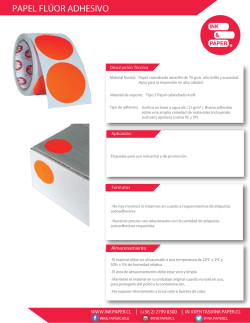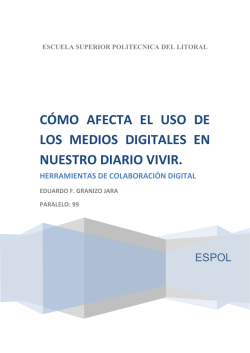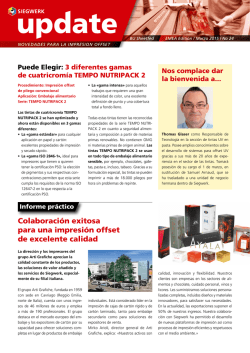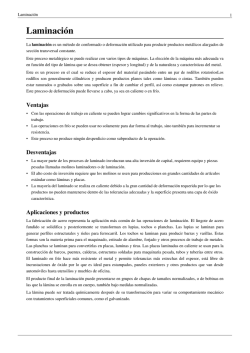
Narrow Web
Narrow Web BU Narrow Web EMEA Edition / Enero 2015 / No 84 NOVEDADES PARA LA IMPRESIÓN DE ETIQUETAS Nuevo Blanco Opaco para flexografía UV en sleeves Procedimiento: Impresión flexográfica UV Aplicación: Sleeves No de producto: 81-010287-1 Flex White Sleeve 0003 Este nuevo blanco destaca por su excepcional opacidad, una excelente resistencia al arañado y unas propiedades de impresión muy buenas. La combinación de gran opacidad y baja viscosidad se logra combinando materias primas especiales con un pigmento de gran opacidad. Al mismo tiempo, la formulación garantiza un bajo coeficiente de Barniz de sobreimpresión «Soft-touch» en base agua Procedimiento: Impresión flexográfica Aplicación: Etiquetas Código de producto: 10-604727-7 WB TOB OPV Soft Touch deslizamiento que permite que la manga deslice suavemente sobre el envase. Utilice este blanco estándar de flexografía UV para aquellos recipientes que tengan función barrera. Para recipientes sin función barrera, Siegwerk ofrecerá pronto un blanco de baja migración en la serie SICURA Nutriflex. Guía para clientes: Tintas de impresión para embalaje alimentario La guía revisada ofrece información útil sobre la seguridad del producto y las cuestiones legales relativas al embalaje alimentario. A diferencia de la primera edición, muy popular ya entre nuestros clientes, la nueva guía revisada también aborda las normativas y legislaciones aplicables en todo el mundo. En estos momentos, la guía solo está disponible en inglés. Para ver y descargar la guía, haga clic en siegwerk.com. Este nuevo barniz de sobreimpresión para etiquetas autoadhesivas crea una agradable sensación sedosa de piel de melocotón. El barniz posee una baja viscosidad por lo que es ideal para su uso en máquinas de impresión flexográfica y unidades de barnizado. Destaca por una buena resistencia a la abrasión, sin formación de burbujas ni amarilleamiento. Un barniz de sobreimpresión excelente que aporta a las etiquetas un efecto agradable al tacto y visualmente atractivo. El barniz está especialmente indicado para su uso en papel y en determinados soportes plásticos, y está aprobado para aplicaciones alimentarias. En papeles muy absorbentes, se recomienda imprimar con laca transparente. Nuevas denominaciones para series de productos Siegwerk Como consecuencia de la reestructuración global de las unidades de negocio Sheetfed y Narrow Web, Siegwerk unificará las denominaciones de las series de determinados sistemas de tintas. A continuación encontrará cinco ejemplos destacados de nombres de series que se armonizarán bajo el concepto de la nomenclatura global. La novedad es que los productos y las series de baja migración llevarán el prefijo «Nutri». Esto permitirá identificarlas al instante como productos aptos para aplicaciones alimentarias. Para obtener la lista completa de las designaciones de nuestras series, póngase en contacto con su técnico de aplicación de Siegwerk o visite nuestro sitio web en siegwerk.com. Denominación anterior: SICURA Plast SICURA Plast Nutritec SICURA Flex 39-10-LM SICURA Flex White LM SICURA LAB OPV Flexo Nueva denominación: SICURA Litho Plast SP SICURA Litho Nutriplast SICURA Nutriflex 10 SICURA Nutriflex White SICURA Flex OPV Narrow Web BU Narrow Web Etiquetado GHS: obligatorio a partir de mediados de 2015 GHS = Globally Harmonized System, es el sistema globalmente armonizado para la clasificación y etiquetado de productos químicos. GHS es un método de clasificación desarrollado por la ONU, con el consenso internacional y de aplicación en todo el mundo, que incorpora pictogramas uni- ficados con el objetivo de minimizar el peligro para la salud humana y para el medio ambiente durante la producción, el transporte y el uso de productos químicos. GHS entró en vigor para sustancias puras (como el alcohol) en diciembre de 2010, y se aplicará también a compuestos (como mezclas, tintas de impresión y barnices) a partir del 1 de junio de 2015. Los símbolos anteriores han sido reemplazados por los pictogramas de peligro. Esto ha dado a Siegwerk la oportunidad de revisar su propio concepto de etiquetado y de diseñar etiquetas nuevas y atractivas para los envases de tinta. EMEA Edition / Enero 2015 / No 84 Nuevo adhesivo para laminación UV de baja migración Procedimiento: Impresión flexográfica UV Aplicación: Etiquetas laminadas para embalaje alimentario Código de producto: 85-600778-6 adhesivo para laminación 39-10 LM 2K Catalizador: 71-470074-7 LM 90 (2 al 4%) Este adhesivo para laminación de dos componentes y optimizado para baja migración ha sido desarrollado especialmente para etiquetas de alimentos. Normalmente, los adhesivos para laminación UV convencionales contienen mono- y di-acrilatos en el vehículo y, por lo tanto, difícilmente pueden cumplir la normativa legal sobre embalaje alimentario. El nuevo (Extracto del boletín «explicit» sobre este tema) adhesivo para laminación UV de dos componentes de Siegwerk Dada su reactividad química, los colores Pida a su técnico de aplicación de Siegwerk destaca por su bajo potencial de UV son más susceptibles de envejecer que le envíe el boletín «explicit» sobre el migración, mientras que sus resulprematuramente que las tintas conventiempo de vida media de las tintas UV. tados de laminación superan a los cionales. de sistemas de un solo componente. Independientemente del método de imSe utiliza para la laminación en línea de presión, la fecha de producción suele estar b etiquetas autoadhesivas de polietileno y e W impresa en los recipientes de tinta de imNarrow polipropileno impresas con tintas de la serie ing t stamp presión. Por lo general, una estabilidad o h r, UV SICURA 39-10 LM. Para un mejor funfe s al tran r therm ting de 12 meses está garantizada, siempre fo ls e cionamiento en máquina, el adhesivo para rin Lab ld foil p and co que la tinta se transporte y se almacene laminación se puede calentar hasta 50 °C. conforme a las especificaciones del fabriWeb cante. w o r r Na ricks Igual que los alimentos pueden seguir and t Tips – g siendo comestibles días o semanas después rintin hic p Narrow Web grap de la fecha de uso recomendada, una Flexo tinta de impresión puede usarse durante ishes inks and varn Shelf life of UV un tiempo determinado después de su fecha de expiración. Si, después de agitarla, la tinta UV está homogénea, no presenta ningún grumo y muestra la misma viscosidad que una tinta fresca, se puede utilizar para la impresión. Por el contrario, si la tinta se ha vuelto más viscosa o densa, o si presenta grumos, debe descartarse. Vida Media de las tintas UV r 2014 Novembe od s very go rprint ha ; the ove and is stic labels atching, ed for pla re and scr suitable ommend g, moistu bons are smudgin rib to d bri nce d the s. Hy resista chemical labels, an istant to d plastic even res moisture. er, hot paper an duction al transf ging and d coated 1. Intro to smud for therm d matt an d nce nte ne for ista pri sig a res ial de t therof rolls of has good ng mater is direc consists overprint the back The labelli er printing l printing bon. In thod) on al transf or cold foi an ink rib by any me t of therm stamping h els. On the not use (printed One varian esive lab paper wit ich does material self-adh oved terial is ing, wh for ma rem surface e int el be siv pr lab l he st the to ma is an ad nting, the guided pa substrate pri is d s al ize thi rm of which con the ting; direct the e is a sili black at face coa sid e ns sur te siv tur ve ara siti adhe a sep ies. nter and label. 14 a heat-sen offline on ious qualit xing the ess pri ber 20 ntarindnthe is done es in var when affi foil printeleme-h Novem printing paper com and cold heatingmedium Therm for colortransfer ts alor suitable t stamping ft or areas. Thermal pers are elemen d for printer. Ho g a soactivarted inpblock ated thermal pa transfer ly intende us on ine. fo pro ly t offl d are -co thermal en no or rs de top pe inline ialedoeves mmen Most mor ile eco-pa be done h ter nted ma is re nt,cohot ing can labels, wh ng is labels. er pri if the pri muc al tra tape printed rdnsf setti can arise -colored sed re gle therm. Ha eas. mber 2014 Problems esd,susin turing rai sequent tape inted arNove both shoctrt-lprive rolls fea sure t the sub e corre ntact pres printing. d l print.solid pr stanmping erly accep Th foi , an ee d r ing col g: tw prior to co t stampd be orlle ttin print x ro heated the rrect n ate an nts de re se stampe,inganilo thar.t Aare pends on the co Ininho cially ting pl eleme aratio Pressu rtant, i.e. 0 °C) de cylin pr mp or blad This is espe 22 n ing d ct to mpsio an sta up do 1. Prep d sta po lly in an lleelr uarta pres ure (us ber . In the aned. oces lab very im ilodx ro ratwith a ce rds inks substrate , cham annte trate /im e pr tempe come fully cle2. Thith standa n thepri ,eethe untain utds the d-oan d asubs The to work foil dr ing tool ing t be use oily or printbe an tw w mp op us m e as y Ink fo sta r m is at el ing e pl nte at fer gy stampthat no of the uesl fro consists tinerg pri trans nsf sidma g plat semialtern strate hot e» leadas reer sedn are al tra prin inting. l, which color pigments, ingth printin arate orking rv so s, the at , ca ployed For s in pr o a thermthe errai mping foi • Fana er is ents: These l pigm lyntema sep afety reseing proces nt if w ntamin oblem erted int howev h the hohitchsta monpri shes,a separating lay ich can lly of metal salts, «s r to pr ial is ins e, w sure, tacr-bas and varnifoi importa tion inks. Co ad ter inks l, lema nter, wh com er aprinte acsed d rs, consist partia pres gedplat nsfas wateinttinwit le linanbinde rier soland o con sure ltigra n also For this digital pri nty t int nt-ba arecar suof rmpralestra ing too pr e solve Onke the ated stampsolub . ta Unlikgh a co ers ca tin low-m theera metallic pigments. This is a ers over The the to ration l. an rly ing lay of el. evapo l rol simila tur (= r up cle er hi lab ss he ve k fea lay ch sev ive in the nto wea cal ting whicherbeha of proce can alphysi inca r. To dry n for ea ni whichec lts due to y ng elecume een lubrica cess thatnme ical process. This transf life of 6 months hatw inscriptio d exms m . Be nganatitheati oc contro harde in a chem transfer layer. rlled lic ora limited shelf talonly syste reaso nt applied EBr an ea men, eate pri inkusiqu and its w s n lly of UV gr , e e thi withi ua er ses vent) cts. or) d ur to ined th es lay relears contammon individ appli are be an emator col to light, ponbinde one for these produ the prack (bl co substance (= lines t can ttings aing be) guara thereu here cellsbe on thenteed . r of tsink ment,s ato expo ain, ram insed mpwhich 2. Se t form then ng(num tha sta acsar ing atigng ele lead When portant heati an nt cules intpr intin of: aAg he y a holog re mole ts d r he rpr pr Im co cle free sis an su ad lle e e : ove ces tackun , ial con weeks ro es ad if ne ms er x intocellarge pr ich the g in crosslink ng ls el massterof th d are other side. The e several days or syste ctorntsbl transf me in, orUV to e anilo theelab rapi d,ononly wh in the doused ntactThe binde pig heati e co can still be edibl finene introd e on the Ink at the foods s hesiv for th asnce ssivde rs uresuceor ink. colore Juststa of d by ther dry leeadad generally still be , bladfilm l as th bon is struct n iswith exce s (so-c cations Thisctiv is r,heate octo ctio groupos areaalled it fe a rea mping sub their use-by date, a UV system can ance d ». trans k y react as wel inktedrib(fine ss ansubst specifi A distin D e ne mndst the staare inkere –e wh wyorhighl sidive us re after lts terial.accor lume) to fo th prin rtially me tio bo dingl ma n x date. vo y e is g tly shes its el au esi expir ilo be p e Th en and varni lly pacalculatin wax/r«overc reasoen,peUV inks rman time after its etheanlab ovelal.material. pick-u mistak ns andou ents to r es cia remlab this e siv fortoth t ofFor lly used for a certain ² in ribboacryla ed ed tion the inkor traecnsf eriza ifierr or elem ad – al to umb fo– ankd sp polym right ns,mres as sureontes). 6 g/ ly partia tim aging ribbo d are plate x e: presare ature op ctor blto prem ate le of th wapl at the of in e doptible tw.een susce le tohesub(Exam stingor watees r-bas the ink As a ru more tab ount made be x kribbons ea of th sureed of in d resed tell whether m² wa – andthan solve ere nt-ba an lines). w r onlyitssui bstratebons, twh e pr g/ the am elf iner b) How do you sisture andinare cessiv ptible ethan ou 2 -ld be clean the su rid rib e conta of the or 1/3 of Ex rec ab ad t . to ct mo bl are d to susce es fa d hyb ou sid s r ? g an ab vely less ng the the ribbons e shou ms are relati l tim ferre othe appears smud equate can still be used se,gin e . Resinsyste ni initiators.sults bladEB systex roller at al e, mea ms. thels is trans or UV varnish cation resista).ntOftocour peroflab roller paes doctor ilo se they conta g, the UV ink lin This re te bladin no photo ted stirrin an specifi of r r. e e after coa tra r If, becau lle th e th un he bs ms ro th exhibits the same at su for matt, mbe UVglsyste e to ion of tly lift the fe anilox no lumps at all and an eter of to the the nu format d of or sligh be used homogeneous, has , diam ch as rred on d the bend instea ferred ink or varnish can r cells or type re, su an the n s ns lle e, he then e transfe ca pe ink, ro tra ad ad ay viscosity as fresh e scrashelfonlife of the ctor bl the bl of ink conta into pl in-s. ink or varnish has bladmum a)theMini oudntonto thehu the do come e shift other hand, the ometry ink is usuallye printe of date gle of printing. If, on the th am ller, ge and shes is present, for up ; an are ro ction ea s in ts ild x d produ lump lin le ga The any r t and varni anilo in bu doinks or rubbery or if type an k drop life x rolle goftoUV become viscous roller, ted innteed shelf plate ers.unThe to anilo leadin of. groups wanguara anilox inting lution eases,ths. The following product must be disposed incrmon r a pr trate. ate so (or normally then the product lly12 ple: Fo ting pl es/cm of subs gradua life: in am lin shelf pr Ex onth 0 this 12-m 1:6. tio of ture with 36 are excepted from about The ra roller storage tempera conould be anilox c) Transport and ct only applies if the . ture sh m, an s: The base produ ssible shelf life naturally depend lines/c , The guaranteed ponent hardener ed if po lt can perishable foods ner with 60 be us pe. • Two-com t resu handled. As with hs, but the harde ly ta in ld mont priate pr 12 e ou for e appro at is r sh pl are also taine lly be kept : Th more) port and storage tape inting am can typica trans t g pr fo durin res gh e nt high temperatu the ri res influence suitabl for 4 months. differe eratu only d of temp ng in si High rre ce ist systems. nsfe Choo e choi harmful to UV pes ex are tra lead to premature on th sive ta texts l surfaces can react initiators and can greatly h : Because meta e adhe the sensitive photo s and by the ink/varnis • Metallic inks g plat s, UV metallic e area can be recognized Printin the acrylate group Halfton polymerization. This spontaneously with sses. us or rubbery. below). f visco ne Point cally rd (see elasti ha al handling becoming hard, inks require speci months. Shelf life only 4 Siegwerk Switzerland AG CH-3282 Bargen/Switzerland Business Unit Narrow Web – Center of Competence Tel. +41 32 391 72 00 www.siegwerk.com
© Copyright 2026



